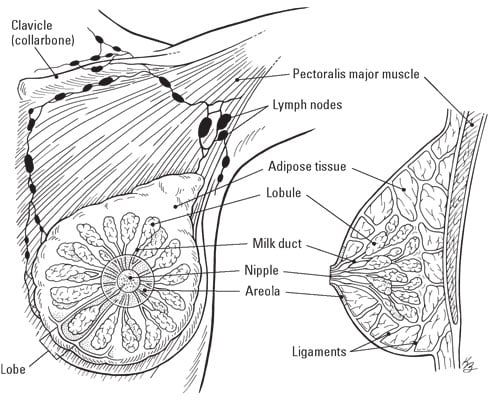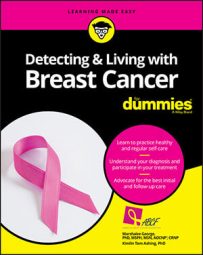Finding your way around your breast
The breast extends from the collarbone to the underarm and across to the middle of the chest at the sternum. The breast is mostly made up of adipose tissue, which means it's a collection of fat cells. The size and number of fat cells in the breast are influenced by many hormones, genetics, growth factors, and lifestyle behaviors — and the female hormone estrogen.The breast is divided into 12–20 sections called lobes. In these lobes are many small glands called lobules, which produce milk in nursing mothers. Milk ducts are small channels that collect the milk that is produced in the lobules and convey milk to the nipple. Throughout the adipose tissue of the breast is a network of ligaments, fibrous connective tissue, nerves, lymph vessels, lymph nodes, and blood vessels. The figure shows the breast and some of its parts.
 Illustration by Kathryn Born
Illustration by Kathryn BornThe illustrated breast.
Here are a few more important parts of the breast:
- Areola: Dark area around the nipple.
- Blood vessels: Help carry blood throughout the tissue.
- Connective tissue: Made up of muscles, fat, ligaments, and blood vessels. It provides support for the breast, gives shape to the breast, and separates or binds other tissues within the breasts.
- Lymph nodes: Small kidney bean shaped pieces of tissue that are connected by lymphatic vessels that are part of the immune system. They are located in various areas throughout the body and act as a filter for getting rid of abnormal cells from healthy tissue. The majority of the lymph nodes that filter the breast are in the underarm area (armpit).
- Lymph vessels: Lymph vessels are a network of vessels running throughout the body. They are part of the immune system that transports disease-fighting cells and fluids.
- Nerves: Provide sensation to the breast.
Knowing about breast cancer risk factors and indicators
It's not just women who are at risk for breast cancer — men are too. Everyone needs to know how to lower the risk of breast cancer, and that includes considerations for modifiable factors (things you can change) and nonmodifiable factors (things you can't change).Even if you have one or more of the risk factors for breast cancer, it doesn't mean you will get breast cancer. Many people have risk factors for breast cancer but never get it, and others who don't have risk factors do get breast cancer. The key is to know your risk factors for breast cancer and minimize them as much as possible to reduce your risk.

